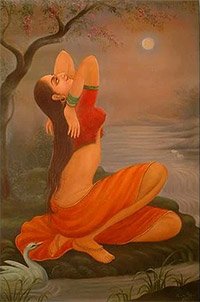Sampathya, Sampāṭhya, Sam-pathya: 3 definitions
Introduction:
Sampathya means something in Hinduism, Sanskrit. If you want to know the exact meaning, history, etymology or English translation of this term then check out the descriptions on this page. Add your comment or reference to a book if you want to contribute to this summary article.
In Hinduism
Kama-shastra (the science of Love-making)
Source: Shodhganga: Elements of Art and Architecture in the Trtiyakhanda of the Visnudharmottarapurana (kama)Saṃpāthya (संपाथ्य) refers to “deciphering by code” and represents one of the “sixty four kinds of Art”, according to the Kāmasūtra of Vātsyāyaṇa.—Indian tradition, basically includes sixty four Art forms are acknowledged. The references of sixty four kinds of kalā are found in the Bhāgavatapurāṇa, Śaiva-Tantras, Kāmasūtra of Vātsyāyaṇa etc.

Kamashastra (कामशास्त्र, kāmaśāstra) deals with ancient Indian science of love-making, passion, emotions and other related topics dealing with the pleasures of the senses.
Languages of India and abroad
Sanskrit dictionary
Source: Cologne Digital Sanskrit Dictionaries: Monier-Williams Sanskrit-English DictionarySampāṭhya (सम्पाठ्य):—[=sam-pāṭhya] [from sam-pāṭha > sam-paṭh] mfn. to be read or recited together with (cf. a-s).
[Sanskrit to German]
Sanskrit, also spelled संस्कृतम् (saṃskṛtam), is an ancient language of India commonly seen as the grandmother of the Indo-European language family (even English!). Closely allied with Prakrit and Pali, Sanskrit is more exhaustive in both grammar and terms and has the most extensive collection of literature in the world, greatly surpassing its sister-languages Greek and Latin.
See also (Relevant definitions)
Partial matches: Sam, Pathya, Cam.
Starts with: Sampatyam.
Query error!
Full-text: Asampathya, Sampatyam, Path.
Relevant text
Search found 4 books and stories containing Sampathya, Sam-pathya, Sam-pāṭhya, Sampāṭhya, Saṃpāṭhya; (plurals include: Sampathyas, pathyas, pāṭhyas, Sampāṭhyas, Saṃpāṭhyas). You can also click to the full overview containing English textual excerpts. Below are direct links for the most relevant articles:
Kamashastra Discourse (Life in Ancient India) (by Nidheesh Kannan B.)
7.1. The Sixty-four Fine Arts < [Chapter 5 - Looking for Alternatives: Possibilities in Kāmaśāstra]
Malatimadhava (study) (by Jintu Moni Dutta)
Part 3 - Art and Architecture in the Mālatīmādhava and 8th-century India < [Chapter 4 - Cultural Aspects of the Mālatīmādhava]
Shringara-manjari Katha (translation and notes) (by Kumari Kalpalata K. Munshi)
Hindu Architecture in India and Abroad (by Prasanna Kumar Acharya)